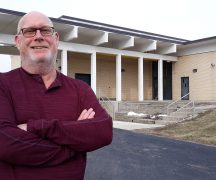By DAVID DUPONT
BG Independent News
If members of council get complaints about “blocked” sewer drains after heavy rains, they should pass them along to the city, Brian O’Connell, Bowling Green’s utilities director, said.
But if those complaints are from residents in the downtown and other older neighborhoods, that slow drainage likely is by design, he told city council Monday night.
O’Connell reported that 40 percent of the drainage in the city are combined water and sewer pipes. These are in the downtown and older neighborhoods. The remaining 60 percent are separated. In those cases separate pipes take sewage to the water treatment plant and the storm water flows directly into the Maumee River . In the case of combined pipes, the sewage and storm water runoff all flow into the same system. And it all goes to the water treatment plant on Poe Road.
This can, and does, occasionally lead to overflows when there’s too much volume for the water treatment plant to handle. The overflow is then discharged into Poe Ditch and makes its way to the Portage River, and eventually to Lake Erie.
Bowling Green is allowed to have not more than such four such discharges before the city gets fined.
And it stays within that, O’Connell said.
In 2019 it had three or four incidents. In 2020 it had two or three, he said. This year, so far it has had two, and one was caused by a power outage at the treatment plant.
The city has taken measures to prevent these overflows.
One includes putting restricting orifices on most sewer pipes that handle combined waste water and storm runoff. While residents like to see that storm water flow off the streets and out of their yards as quickly as possible, the city prefers to hold it there for a bit to reduce the volume going to the water treatment plant.
The city has increased its maximum treatment capacity to 30 million gallons and installed a 5 million gallon holding tank.
Bowling Green benefits from having only one site at the treatment plant where an overflow can occur. Other municipalities have multiple spots where overflows can occur.
In response to a question from John Zanfardino, who represents the Second Ward on council, O’Connell said this is not related to sewage backups in buildings. Those are caused by blockages, such a tree roots growing into the pipes, that are usually the property owners responsibility to fix.
After the meeting, O’Connell also provided some insight for residents who keep asking why the windmills at the landfill frequently seem not to be working. The equipment, he said, is 18 years old. The expected lifespan of a wind turbine is 20 years. The technology has evolved so when something breaks, it’s difficult to get replacement parts. Also, newer turbines have digital technology that allows remote diagnosis of their problems. Someone has to actually go and physically examine the turbines in BG to figure out what’s one wrong.



